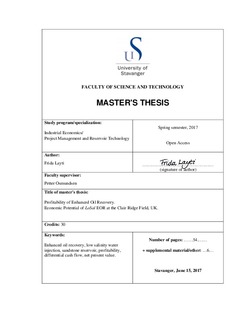| dc.contributor.advisor | Osmundsen, Petter | |
| dc.contributor.author | Layti, Frida | |
| dc.date.accessioned | 2017-09-22T11:12:27Z | |
| dc.date.available | 2017-09-22T11:12:27Z | |
| dc.date.issued | 2017-06-15 | |
| dc.identifier.uri | http://hdl.handle.net/11250/2456243 | |
| dc.description | Master's thesis in Industrial economics | nb_NO |
| dc.description.abstract | Low salinity water injection is an emerging enhanced oil recovery (EOR) technology, just on the verge of being implemented at full scale at the Clair Ridge field, UK. Clair Ridge will be the world’s first offshore deployment of BP’s LoSal EOR technology. The method will be implemented as a day one, secondary waterflood and is expected to deliver an additional 42 million barrels, at a cost of only 3 $/bbl. Over the last twenty years, there has been a significant growth in the evidence supporting the technology, but there is a limited amount of papers where the profitability of the method is discussed.
Profitability is the primary driver of any project. Thus, the objective of this thesis is to evaluate the profitability of LoSal EOR at Clair Ridge, and contribute to an improved insight in to the economics of EOR. This is done by combining both technical and economic aspects of the Clair Ridge project. Through a literature review of the reservoir mechanisms and deployment of EOR projects, three main challenges are identified: technical, managerial and economic.
The economic challenges are further analyzed by calculating the differential cash flow from the Clair Ridge field. The project’s net present value (NPV) is also obtained and evaluated. The results indicate that LoSal EOR is profitable under the given assumptions and circumstances. Additionally, scenarios including traditional waterflooding and tertiary EOR are investigated to illustrate the added value of LoSal EOR. From the observed results, it is clear that LoSal EOR is the preferred project.
Finally, the effects of delayed production peak and timing of EOR investments are discussed. Although production curves and cash flows are strongly related, it is found that a delay in production peak has a minor effect on NPV. However, results show that an investment made early in the lifetime of the field has a favorable influence on NPV. Hence, it is strongly recommended to include an EOR strategy from the beginning of the field development. | nb_NO |
| dc.language.iso | eng | nb_NO |
| dc.publisher | University of Stavanger, Norway | nb_NO |
| dc.relation.ispartofseries | Masteroppgave/UIS-TN-IØRP/2017; | |
| dc.rights | Navngivelse 4.0 Internasjonal | * |
| dc.rights.uri | http://creativecommons.org/licenses/by/4.0/deed.no | * |
| dc.subject | prosjektledelse | nb_NO |
| dc.subject | low salinity water injection | nb_NO |
| dc.subject | sandstone reservoir | nb_NO |
| dc.subject | profitability | nb_NO |
| dc.subject | differential cash flow | nb_NO |
| dc.subject | industriell økonomi | nb_NO |
| dc.subject | net present value (NPV) | nb_NO |
| dc.subject | enhanced oil recovery (EOR) | nb_NO |
| dc.title | Profitability of Enhanced Oil Recovery. Economic Potential of LoSal EOR at the Clair Ridge Field, UK. | nb_NO |
| dc.type | Master thesis | nb_NO |
| dc.subject.nsi | VDP::Samfunnsvitenskap: 200::Økonomi: 210 | nb_NO |
| dc.subject.nsi | VDP::Teknologi: 500::Berg‑ og petroleumsfag: 510::Petroleumsteknologi: 512 | nb_NO |

